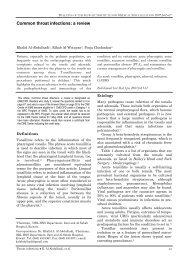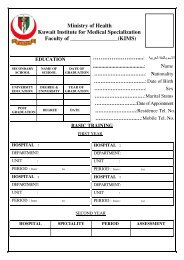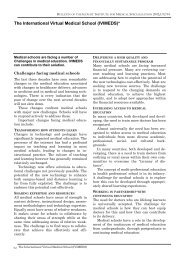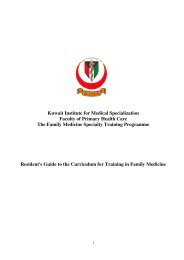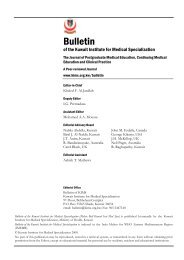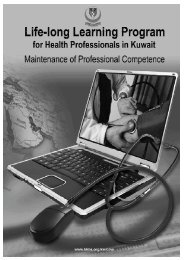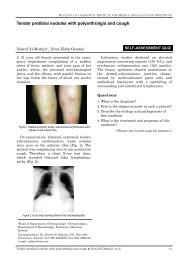Otitis media: a review for the Family physician - Kuwait Institute for ...
Otitis media: a review for the Family physician - Kuwait Institute for ...
Otitis media: a review for the Family physician - Kuwait Institute for ...
You also want an ePaper? Increase the reach of your titles
YUMPU automatically turns print PDFs into web optimized ePapers that Google loves.
BULLETIN OF THE KUWAIT INSTITUTE FOR MEDICAL SPECIALIZATION 2003;2:83-89<br />
months. Some investigators have also noted a<br />
second, lower peak between ages 4 and 5 years.<br />
The onset of AOM during <strong>the</strong> first year of life<br />
is important because <strong>the</strong> majority of children<br />
with multiple recurrences of AOM have <strong>the</strong>ir<br />
first episode be<strong>for</strong>e <strong>the</strong> age of 12 months. 1<br />
An epidemiological survey in Saudi Arabia<br />
was carried out with 9540 children aged up to<br />
12 years to study <strong>the</strong> prevalence of acute otitis<br />
<strong>media</strong> and <strong>the</strong> rate of hearing impairment. A<br />
total of 100 (1.05%) were diagnosed with acute<br />
otitis <strong>media</strong>. The incidence was found to be<br />
higher among young children up to 4 years old<br />
and lower in <strong>the</strong> age group 8-12 years. Also it<br />
was found that <strong>the</strong> prevalence of AOM was<br />
higher among children whose parents were<br />
cousins compared with children of non-related<br />
parents. There is also evidence to indicate that<br />
poor socio-economic backgrounds and inadequate<br />
health services are associated with a<br />
higher rate of <strong>the</strong> condition. 5<br />
After an episode of AOM, <strong>the</strong>re is a high<br />
incidence of persistent middle ear effusion<br />
(MEE) occurring. One study found that <strong>the</strong><br />
mean duration of otitis <strong>media</strong> with effusion<br />
(OME) after AOM was 40 days. Shurin et al.<br />
reported that children who were younger than<br />
24 months of age were 3.8 times more likely to<br />
have persistent MEE than those who were<br />
older. 6 They also found a higher incidence of<br />
persistent effusion in white children.<br />
Varying distribution among sexes has not<br />
been found. Some studies have shown an<br />
increased preponderance in males when compared<br />
to females but o<strong>the</strong>rs have challenged<br />
this finding, citing an equal distribution. 1<br />
Children in group daycare have been shown<br />
to be more likely to have OM as a complication<br />
of an upper respiratory tract infection when<br />
compared to those in home care. Niemala et al.<br />
found that <strong>the</strong> rate of tympanostomies and<br />
adenoidectomies was 59-67% higher <strong>for</strong> children<br />
below <strong>the</strong> age of three who were cared <strong>for</strong><br />
at a daycare center. 7 Contributing factors <strong>for</strong><br />
this increased incidence may include large<br />
numbers of children in close proximity and<br />
increased incidence of upper respiratory infections,<br />
with resultant frequent examinations by<br />
<strong>physician</strong>s.<br />
The incidence of OM parallels <strong>the</strong> incidence<br />
of upper respiratory tract infections, which are<br />
most prevalent during <strong>the</strong> winter months. OM<br />
is also common in <strong>the</strong> spring and fall, and least<br />
common during <strong>the</strong> summer. It has been found<br />
84<br />
that MEE originating in <strong>the</strong> winter months<br />
appears to last longer than those occurring in<br />
<strong>the</strong> summer months. 1<br />
There is data strongly suggesting a genetic<br />
susceptibility to OM. Variables associated with<br />
an increased risk of AOM include a sibling history<br />
of recurrent OM. 8<br />
Breast-feeding has been suggested as an<br />
important factor in <strong>the</strong> prevention of respiratory<br />
tract infections and middle ear disease in<br />
infancy. Many studies have shown an inverse<br />
relationship between <strong>the</strong> incidence of middle<br />
ear disease and <strong>the</strong> duration of breast-feeding.<br />
The mechanism of <strong>the</strong> protective effect of<br />
breast milk remains obscure. Data from a<br />
study of infants with cleft palate 8 suggest that<br />
it is a factor in breast milk, and not <strong>the</strong><br />
position or mode of feeding, as some have<br />
suggested, that is protective. Two o<strong>the</strong>r studies<br />
indicate that breast-feeding had no effect on<br />
colonization of <strong>the</strong> nasopharynx with bacterial<br />
pathogens, indicating that <strong>the</strong> mechanism of<br />
protection relies on some immune-protective<br />
feature unassociated with prevention of colonization.<br />
9,10<br />
Passive smoke exposure has come under<br />
increased scrutiny as a risk factor <strong>for</strong> respiratory<br />
tract infections, including OM, because of<br />
pathological and physiological changes in <strong>the</strong><br />
respiratory tract: goblet cell hyperplasia,<br />
mucus hypersecretion, ciliostasis, decreased<br />
mucociliary transport, and alteration of <strong>the</strong><br />
immune defenses. There is also an increased<br />
incidence of placement of tympanostomy tubes,<br />
chronic and recurrent OM, and otorrhea in<br />
children whose mo<strong>the</strong>rs smoked. 9<br />
Many associated medical conditions predispose<br />
a child to OM. Cleft palate and craniofacial<br />
anomalies, especially if <strong>the</strong> midface is<br />
involved, appear to be related to an increased<br />
risk of OM. The incidence of middle ear disease<br />
decreases somewhat after surgical repair of<br />
cleft palate but <strong>the</strong>se children may continue to<br />
have frequent middle ear problems <strong>for</strong> years.<br />
There is an increased incidence of OM in children<br />
with congenital or acquired immune<br />
dysfunction (IgG subclass deficiency, AIDS,<br />
medications). Ciliary dysfunction frequently<br />
predisposes a child to OM (OM may be <strong>the</strong> first<br />
presenting sign of Kartagener’s syndrome). 1<br />
Edema of <strong>the</strong> nasopharynx and Eustachian<br />
tube (E.T.) from prolonged nasotracheal intubation<br />
or nasogastric tube placement may lead<br />
to OM and sinusitis. Nasal obstruction from<br />
<strong>Otitis</strong> <strong>media</strong> ● Rehab Alwotayan et al.






